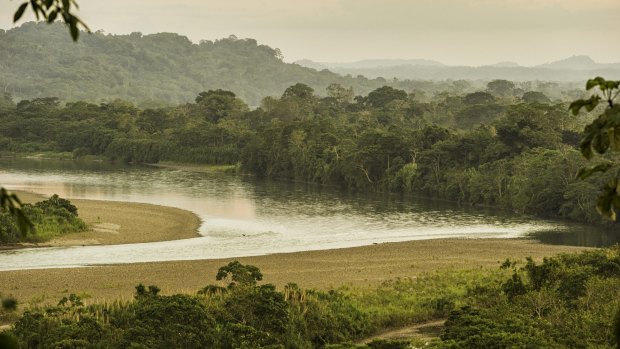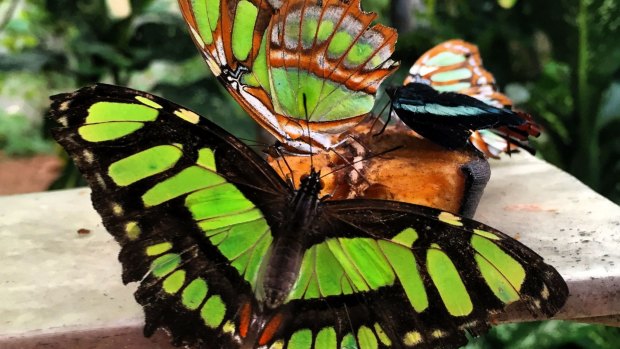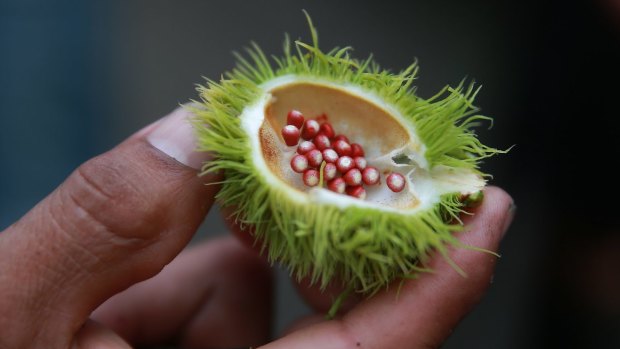By Catherine Marshall

The Napo River runs through the Amazon Rainforest, delivering its watery lifeblood to the villagers living along its banks. Credit: Getty Images
If you scream in the jungles of Ecuador's Amazon, no one will hear you. The malignant spread of foliage will swallow up the sound of your voice. The cecropia and kapok trees, the cancerous vines and creeping ground covers will drown out your voice as surely as they do the sunlight. The red heliconias and yellow shrimp flowers will observe your plight, beautiful but mute. The cicadas, invisible yet omnipresent, will fill the air with their maddening buzz. The butterflies' silence will be betrayed by their lurid colouring: lime green and indigo jewels flitting paper-thin through the thickets. From somewhere far off, the capuchin monkeys will echo your desperate call.
It is a pointless exercise screaming for help in the Amazon, for this jungle has learnt from its most feared creature, the anaconda: it enfolds its secrets and refuses to let them go. Instead, you must find a kapok tree, whose preternatural roots lurk like giant scapula above the ground. You will pluck a sturdy branch from one of the plants encroaching upon you – but be careful where you lay your hands, for tarantulas and poisonous caterpillars and bull ants lurk – and you will beat it against the hollow buttresses of this looming messenger tree. The sound will echo through the jungle, a long and thunderous alarm bell alerting the people to your plight.
Within the suffocating tangle of Misicocha Reserve, Anibal Andi demonstrates this manoeuvre, hammering a branch against the tree's skeleton-like roots so that the earth rumbles. Andi is an indigenous Quechua man who was born on Anaconda Island, which straddles the converging Napo and Arajuno rivers. Much has changed in Ecuador's Amazon during his lifetime: the ahuano (the palm tree for whom this region is named) has been almost decimated by loggers; animal species have been displaced; and resource giants have moved in and set up their greedy oil rigs.

Butterflies.Credit: Catherine Marshall
The change is heralded on the drive from Ecuador's high Andean capital of Quito to the Amazon gateway town of Tena: an oil pipeline runs in the opposite direction, skirting bridges and cutting through mountainsides, carrying its precious bounty from the resource-rich Amazon to the oil-thirsty highlands. But the fury at foreign exploitation of local resources is exemplified in the graffiti sprayed across the walls of a crumbling roadside house: Texaco no camas, it says, referencing the American oil company alleged to have caused widespread contamination to the Lago Agrio oil field. Texaco never again.
Down in the steaming, biodiverse lowlands, this tension between economic progress and environmental conservation is being addressed. The 180-hectare Misicocha Reserve falls under the stewardship of La Casa del Suizo, a lodge perched above the churning Napo River. As part of the government's environmental and tourism program, each Amazonian lodge is required to conserve and rehabilitate a tract of land. The animals are returning, and the encroaching foliage conceals any evidence of degradation. Indeed, it is a botanical quagmire, this place, a maze from which the unfamiliar visitor cannot hope to escape.
But it is important that we see this jungle through Quechua eyes, Andi says, for this is their god. It is a magical cabinet that satisfies every practical, spiritual and medicinal need. Here is the chonta palm, from which houses are built and tasty grubs extracted. There is the balsa tree, from which canoes are crafted, and the rubber tree, whose sap is used to seal the vessels. You will find in this jungle leaves to repel insects and evil spirits, and vines to cure cancer and rheumatism. There are bulbs filled with nourishing, lemon-flavoured ants, trees heavy with sweet fruit, and spiked palm roots upon which yucca and sweet potato can be grated. And there are those kapok trees, nature's loudspeaker for the hopelessly lost.

Achoate fruit.Credit: Catherine Marshall
But there is no need to sound the alarm, for Andi guides me safely out of the reserve and onto the banks of the Napo River. We board a balsa-wood raft and float downstream in the driving rain. Breathing comes more easily here on this river: it is broad and cool and its fast-flowing waters froth against the riverbanks. The sky is visible once more; cecropia and kapok trees lunge towards it, their branches aflutter with golden pendulum nests. Jacarandas dust the canopies with their lilac blooms.
If we continued along this tributary for another thousand kilometres, we would intersect with the fabled Amazon River near its birthplace in Peru. All the way along, the Napo would deliver its watery lifeblood to the villagers living along its banks. The first beneficiaries would be the people of Ahuano, the village that sits next to La Casa del Suizo. Here people live in brick and cement houses, lay corn cobs out on the pavements to dry and dance salsa in the evenings.
Further downstream, on the low-lying Anaconda Island, Andi's people submit to the river, synchronising their lives with its fitful mood. Though they've tamed their jungle with plantings of plantain and coffee, vanilla and yucca and cacao, they can't tame this waterway: just a few months ago it rose three metres, breaching the undersides of their stilted palm-and-bamboo houses.
To get to the island we take a canoe downstream, lash it to the riverbank and trek inland, beneath sheets of rain, to Andi's village. Inside one of the houses a Quechua woman grinds yucca and sweet potato to make chicha, a traditional fermented drink. Outside, Andi cradles a prickly green achoate fruit; it is filled with red seeds which are crushed and painted onto the faces of the men before they go hunting, so that bad spirits will be chased away. This is how we hunt, he says by way of demonstration: he sharpens a wooden dart on a set of piranha teeth, dots it with poisonous vine sap and shoots it through a blowgun. It finds its deadly mark in the head of a monkey-shaped target dangling from a line of string in the clearing.
The rainfall is carving deep channels into the jungle floor as we leave the village. At the riverbank, we come up short: the path to our canoe has been blocked by the rising water. We must wade through it to reach the vessel, moving fast before it rises further still and knocks us off our feet. Such are the rhythms of this mighty river, the conversations that pass between it and the hissing jungle, the shape it gives to this island sitting so precariously within its watery clutches. But there is nothing to fear, the Quechua say, for we are cradled by the jungle, and the jungle is god.
TRIP NOTES
MORE INFORMATION
GETTING THERE
Delta flies daily from Sydney to Quito via Los Angeles and Atlanta. Fares start at $2172 including taxes. See delta.com.
STAYING THERE
Rates at La Casa del Suizo start at $US135 a person a night including all meals and tours (except for entrance into the Amazon Rescue Centre and the Butterfly Farm, where additional charges apply). Drinks are extra. See casadelsuizo.com.
Catherine Marshall was a guest of Ecuador's Ministry of Tourism.
FIVE OTHER ECUADORIAN AMAZON ADVENTURES
CANOPY ADVENTURE PARK
Whizz above the jungle floor and through its embracing foliage at Canopy Adventure Park, a short drive from La Casa del Suizo. The park's zip-line uses a bespoke safety system to ensure users are kept safe throughout the experience.
BUTTERFLY FARM
About 20 species of Amazonian butterfly are bred as part of La Casa del Suizo's "living exhibition" butterfly farm, a short walk from the lodge. The spacious enclosure is filled with some of the caterpillars, cocoons and jewel-bright butterflies that populate the surrounding jungle.
KAYAKING AND RAFTING
There's a river here to meet every need: take a kayak or raft down one of the area's class one (slower-flowing) or class two (rapid-churning) rivers for a day of adventure. Participants must be over the age of 12.
ANIMAL REFUGE
Animals that have been mistreated, injured, confiscated from illegal owners or captured by would-be smugglers are cared for at this wildlife refuge on the River Arajuno. Not only does the refuge give visitors an opportunity to see up close the elusive animals of this jungle, it also reinforces the fragility of conservation in these parts.
HIKING
For a more intensive jungle experience, travel by canoe to Cosano, an area on the Arajuno River comprising primary forest, and set off on a hike as easy – or as challenging – as you like.
Sign up for the Traveller Deals newsletter
Get exclusive travel deals delivered straight to your inbox. Sign up now.